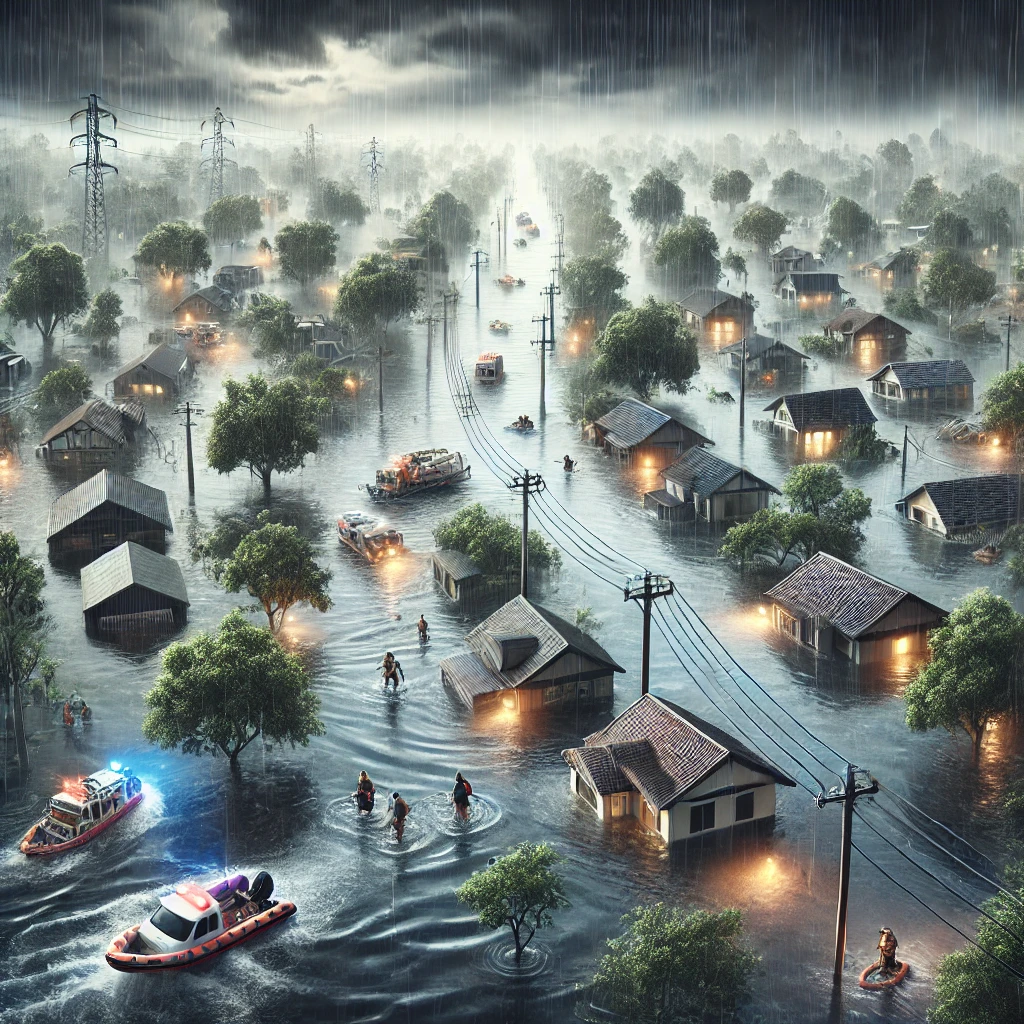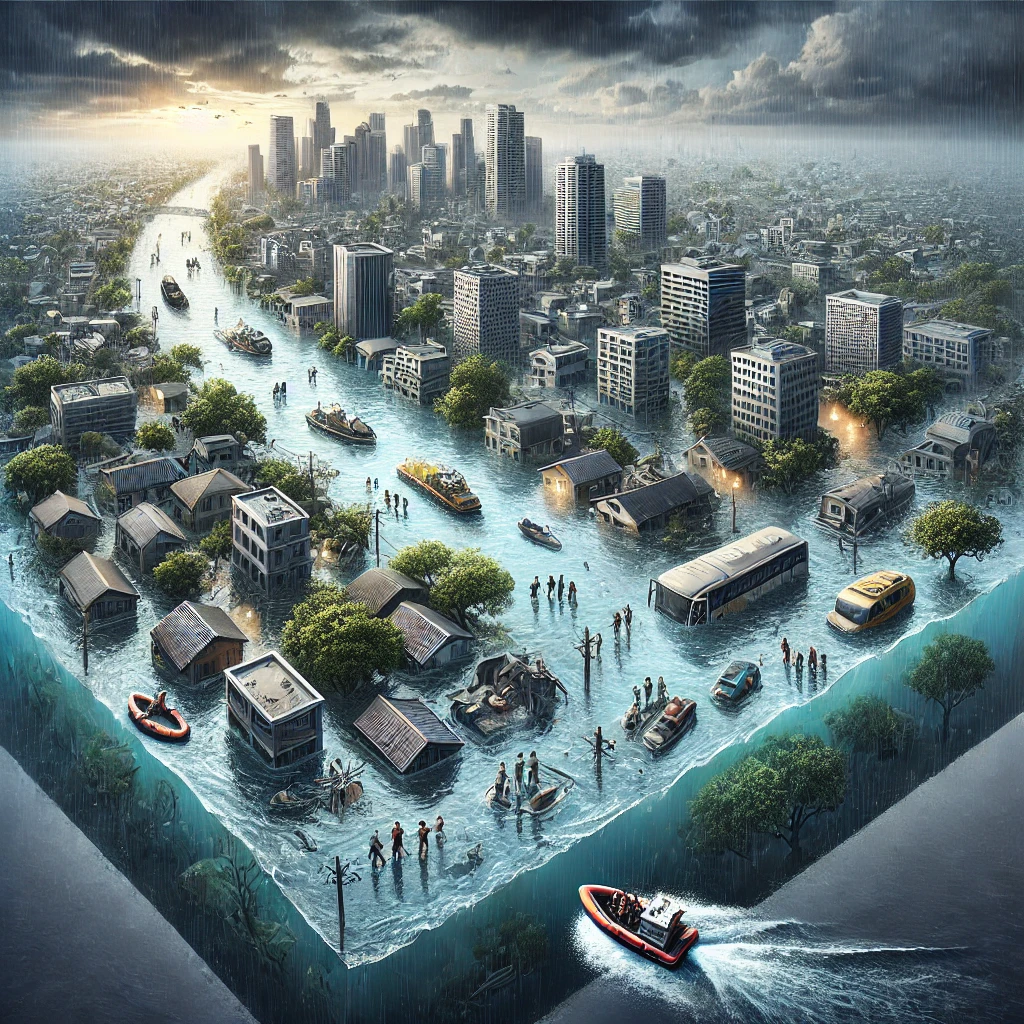
Flood is a natural disaster when water flows overland that is generally dry. It can happen suddenly or take a long time to affect communities and ecosystems. It is crucial to know about flood so that the public will be more ready and respond appropriately in a flood disaster. There are many causes of floods like heavy rainfall within a short period, melting snow in a short period, or the breaking of a dam or levee. A flood’s effects can be catastrophic. They can reach the environment, human life, and infrastructure. Let’s make some lists of things we should consider:
- Flooding caused by heavy rainfall, snowmelt, or storm surges
- Flooding often occurs when heavy precipitation falls on cities that have inadequate drainage systems
- Flash flood can occur with a very minimal warning, which was particularly aggravating.
| GS Paper | GS Paper I |
| Topics for UPSC Prelims | Causes of Floods, Flood-prone Areas in India, Flood Relief Measures, River Basin Management , Importance of Wetlands in Flood Control |
| Topics for UPSC Mains | Impact of Floods on Geography, Flood Management Strategies, Case Studies on Flood Management, Role of Geography in Flood Risk Assessment, Socioeconomic Impact of Floods |
What is a Flood?
Flood refers to the overflowing of water into land that should be dry most of the time. Flood can be in many ways, like river floods, flash floods, coastal floods, and urban floods, among others. Causes and effects vary across the types. This understanding of what actually is flood will enable communities to prepare better for such events.
There are various causes that may lead to flooding. Heavy rainfalls may fall for such a short period that the ground becomes saturated thus causing runoff. Rivers may become overflowing because of excess water falling upstream from the area and bring about flooding. Flash floods occur mainly due to heavy rainfall in a given short period and catch people by surprise.
Causes of Flood
The causes of flood are diverse and sometimes interconnected. Some causes are natural, while some result from human activities.
Natural Causes of Flood
One of the most common natural causes is too much rain. If the rain falls so fast that the ground can’t soak it up, water begins to pool. There’s also flooding due to overflowing rivers, especially after non-stop rain has fallen for several days. Another cause of flood is the sudden melting of snow, making the water level rise in rivers.
- Heavy Downpour: Long periods of rain can overwhelm drainage systems. It is also one of the reasons why urban flooding often occurs.
- Snowmelt Flooding: Melting snow in spring can flood a river very quickly.
- Storm Surges: A hurricane or tropical storm can force a huge quantity of ocean water into areas along the coast, causing flooding.
- A failure to maintain dams can cause them to release a huge volume of water suddenly, resulting in downstream flooding.
- Deforestation: Since trees take up water, if they are removed then less water can be absorbed by the land, thus increasing the flood potential.
Human Causes of Flood
Humans also causes flooding. Deforestation takes the trees which absorb rain water and many large areas are covered by concrete in urbanisation, which does not allow water to enter the soil. Inadequate planning and construction of cities and towns in flood-prone regions also enhances the flood risk.
- Urbanization: Rapid development results in inadequate drainage systems; thereby runoff is increased and the risk of flooding increases
- Deforestation: The rate of soil absorption is reduced by the presence of trees, thus much more runoff, and when it rains, more water hitting the surface.
- Poor land use planning: poor zoning and construction along flood-prone areas increase vulnerability.
- Unsound Agricultural practice: overcultivation along with inappropriate soil care leads to land erosion reducing its capacity to hold moisture.
- Infrastructure Development: The roads and bridges, if not planned well, can interrupt natural waterways thus causing localized flooding.
- Climate Change: Anthropogenic climate change results in more extreme weather conditions raise the level of frequency and severity of floods.

Effects of flood
Effects of flood are disastrous to individuals and communities. It sweeps homes, cars, and even entire villages into the air. It does not only lead to direct losses but also to indirect losses.
Infrastructure Damage
Flooding severely destroys roads, bridges, and buildings, making them costly to rehabilitate. Electricity, water supply, and transportation services will be interrupted. Life and business will also be impacted as communities struggle with long-term economic costs while rebuilding their infrastructure.
Displacement of People
Flooding often forces families to evacuate their homes, leading to temporary or permanent displacement. Shelters become overcrowded, resources become strained, and people are in a state of devastation emotionally, in addition to feeling confused about their future. All these factors tend to affect their overall well-being and stability.
Economic Loss
The economic impact of floods on affected areas can be very destructive. It might mean damage to property, loss of inventory, and even a reduction in customer access for businesses; therefore, local economies may depreciate through job losses and low incomes. This makes recovery for individuals and communities slow and challenging.
Health Risks
For example, water flooding contains hazardous contamination, such as bacteria and chemicals. Standing waters support breeding for mosquitoes that spread malaria and dengue diseases. Since health services may be hindered in the disaster-affected communities, the public health response is bound to be complicated.
Environmental Impact
Flooding has been known to have awful effects on the environment, including soil erosion, habitat loss, and pollution of water bodies. Effects extend to the quality of ecosystems and biodiversity. Natural habitats can take years to recover and are affected by wildlife and plant species that rely on stable environments.
Consequences of Floods
The impacts of flood are long-term and wide-ranging. Floods both kills people and removes property, make the economy weak, and exert pressure on governmental resources.
Ecological Effects
Ecological systems experience floods where it severs and carries away topsoil and nutrients that are crucial for an agricultural sector. In addition to that, flooding promotes erosion of river banks coupled with sliding in mountainous regions. When water bodies receive excess water, marine life will be affected due to its potential to promote pollution or change in chemical content of the rivers.
Social Effects
The social impact of floods is severe. Displacement of families, loss of income, and breakdown of community networks are some of the major social effects of flood. Flood survivors often suffer from emotional trauma due to the loss of loved ones and property.
Long-term Effects
The long term effects of flooding can be terrible and nearly impossible to reverse. Infrastructure, schools, and businesses destroyed by flooding may take centuries to be rebuilt again. Even the economy may be severely affected in poor regions. Moreover, floods even becoming more uncontrollable in many regions where natural barriers such as forests have been destroyed.
How to Mitigate Flood Risks
Country investments in better infrastructure, early warning systems, and disaster preparedness programs may tend to reduce the ill effects of floods. Dams, improved drainage systems, and reforesting areas near rivers may be put in place to serve as flood controls.
Improving City Planning
Ways in which an area from getting developed into a flood-affected area through effective land-use planning. Creation of green spaces within cities and permeable surfaces to accelerate the natural draining process of the city with the least flooding problems, especially in areas considered flood-prone. Implement zoning laws to reduce the development within the areas at risk so the communities are safe through lesser chances of floods.
Controlling Excess Water
The excess water could be controlled through structures, such as the flood control structures of levees, dams, and retention basins. Efforts must be made to maintain and upgrade this available infrastructure to make it function effectively. Such structures can be helpful in diverting the floodwaters from the populated places because controlling the floodwaters is part of what these severe events entail.
Restoring Wetlands
Wetlands act as natural sponges to absorb surplus rainwater and retard runoff. Healthy wetlands provide vital habitats for wildlife and improve water quality. Communities can therefore build resilience against flooding by maintaining such ecosystems.
Community Awareness and Preparedness
Educate the communities on risk management from floods as well as how to prepare beforehand. Regular drills and training are performed to ensure that people know what to do in case a flood ensues. Counseling with sources of further information and materials on emergency preparedness plans, evacuation routes, and safety measures to minimize damage in case of flooding.
Sustainable Agricultural Practices
Advise the farmers to adopt such practices which increase the health of soils and reduce erosion. Cropping, cover cropping and tillage will make the soils absorb much and become firmer. This will consequently reduce the runoff during high intensity rainfalls and increase the surface waters flowing into neighboring land and flood them.
Conclusion
Floods are natural but cause very severe destruction. Knowing what is flood, what are the causes of flood and what are effects of flood aids in taking preventive steps. Floods may be inevitable but the consequences of flood can be reduced with proper planning and awareness among people. We can protect lives and livelihoods from this deadliest force of nature by preparing for its worst and techniques to manage floods.
| Flood UPSC Notes |
| 1. Floods are natural disasters caused by excessive rainfall, melting snow, or dam failures, leading to widespread water accumulation. 2. They can occur in various forms, including flash floods, river floods, and coastal floods, each with distinct characteristics. 3. Floods significantly impact agriculture, infrastructure, and public health, causing economic losses and displacement of communities. 4. Climate change exacerbates flooding risks through rising sea levels and increased rainfall intensity, necessitating adaptive measures. 5. Effective flood management involves early warning systems, proper urban planning, and construction of flood control infrastructure like dams and levees. 6. Communities vulnerable to floods should engage in disaster preparedness and risk reduction strategies, including evacuation plans and awareness programs. 7. Government policies and funding for flood relief, recovery, and research are crucial in mitigating the effects of floods on society. 8. Environmental conservation, such as maintaining wetlands and forests, plays a vital role in reducing flood risks and enhancing resilience. |

